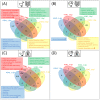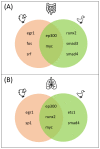Comparative Investigation of Gene Regulatory Processes Underlying Avian Influenza Viruses in Chicken and Duck
- PMID: 35205087
- PMCID: PMC8868632
- DOI: 10.3390/biology11020219
Comparative Investigation of Gene Regulatory Processes Underlying Avian Influenza Viruses in Chicken and Duck
Abstract
The avian influenza virus (AIV) mainly affects birds and not only causes animals' deaths, but also poses a great risk of zoonotically infecting humans. While ducks and wild waterfowl are seen as a natural reservoir for AIVs and can withstand most virus strains, chicken mostly succumb to infection with high pathogenic avian influenza (HPAI). To date, the mechanisms underlying the susceptibility of chicken and the effective immune response of duck have not been completely unraveled. In this study, we investigate the transcriptional gene regulation underlying disease progression in chicken and duck after AIV infection. For this purpose, we use a publicly available RNA-sequencing dataset from chicken and ducks infected with low-pathogenic avian influenza (LPAI) H5N2 and HPAI H5N1 (lung and ileum tissues, 1 and 3 days post-infection). Unlike previous studies, we performed a promoter analysis based on orthologous genes to detect important transcription factors (TFs) and their cooperation, based on which we apply a systems biology approach to identify common and species-specific master regulators. We found master regulators such as EGR1, FOS, and SP1, specifically for chicken and ETS1 and SMAD3/4, specifically for duck, which could be responsible for the duck's effective and the chicken's ineffective immune response.
Keywords: RNA sequencing; avian influenza; chicken; differentially expressed genes; duck; gene regulation; mallard; master regulators; transcription factor cooperation; upstream regulators.
Conflict of interest statement
The authors declare no conflict of interest.
Figures





References
-
- Smith J., Smith N., Yu L., Paton I.R., Gutowska M.W., Forrest H.L., Danner A.F., Seiler J.P., Digard P., Webster R.G., et al. A comparative analysis of host responses to avian influenza infection in ducks and chickens highlights a role for the interferon-induced transmembrane proteins in viral resistance. BMC Genom. 2015;16:574. doi: 10.1186/s12864-015-1778-8. - DOI - PMC - PubMed
-
- Swayne D.E. Avian Influenza. John Wiley & Sons; Hoboken, NJ, USA: 2009.
-
- WHO Cumulative Number of Confirmed Human Cases for Avian Influenza A(H5N1) Reported to WHO, 2003–2020. 2020. [(accessed on 26 March 2021)]. Available online: https://www.who.int/influenza/human_animal_interface/2020_DEC_tableH5N1.....
LinkOut - more resources
Full Text Sources
Miscellaneous

